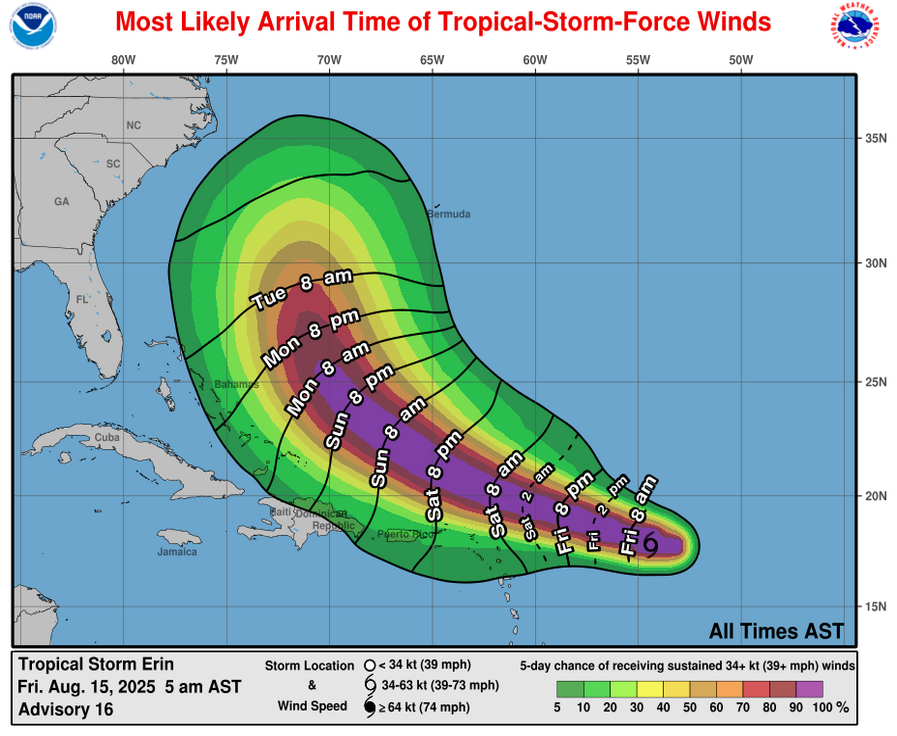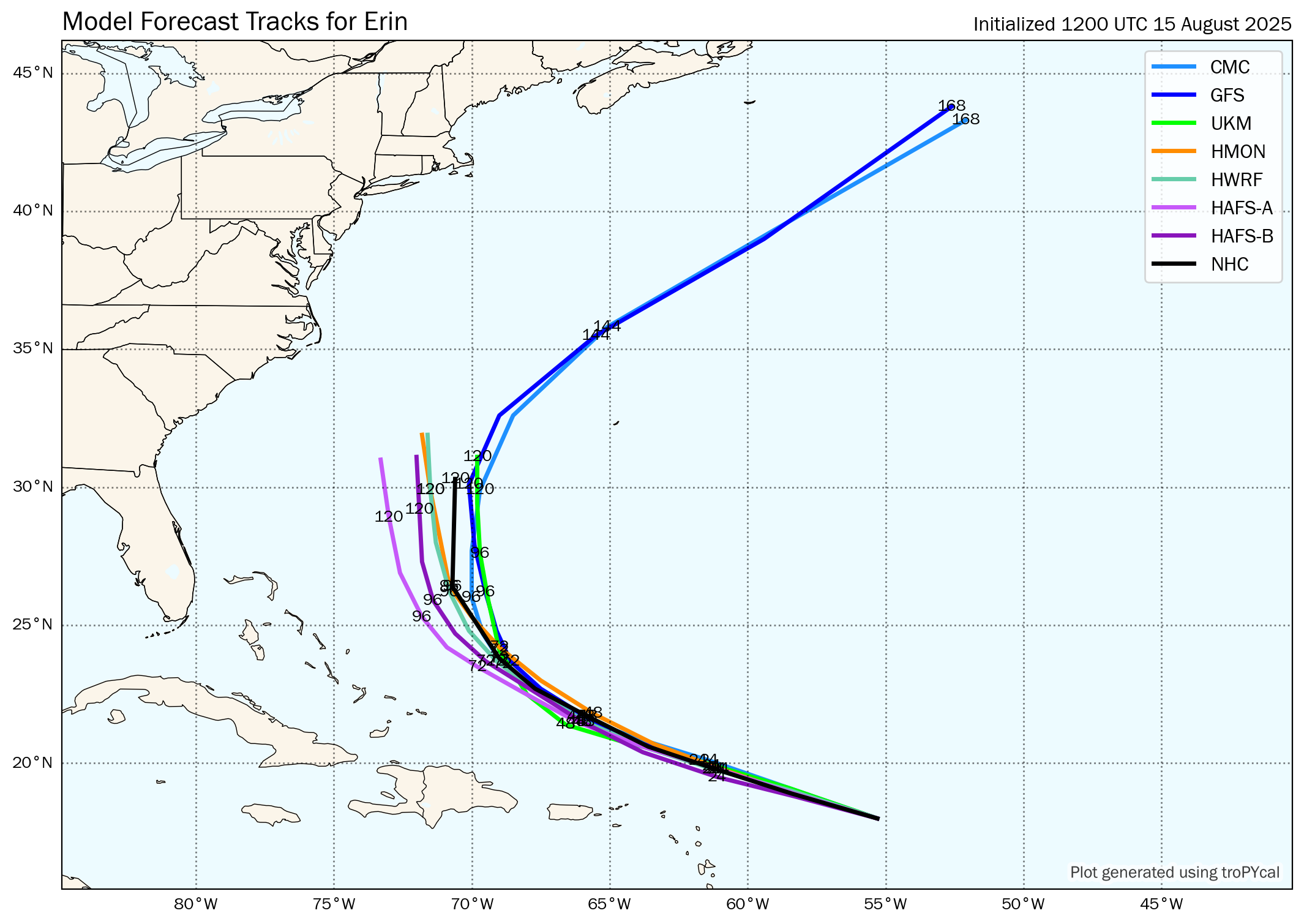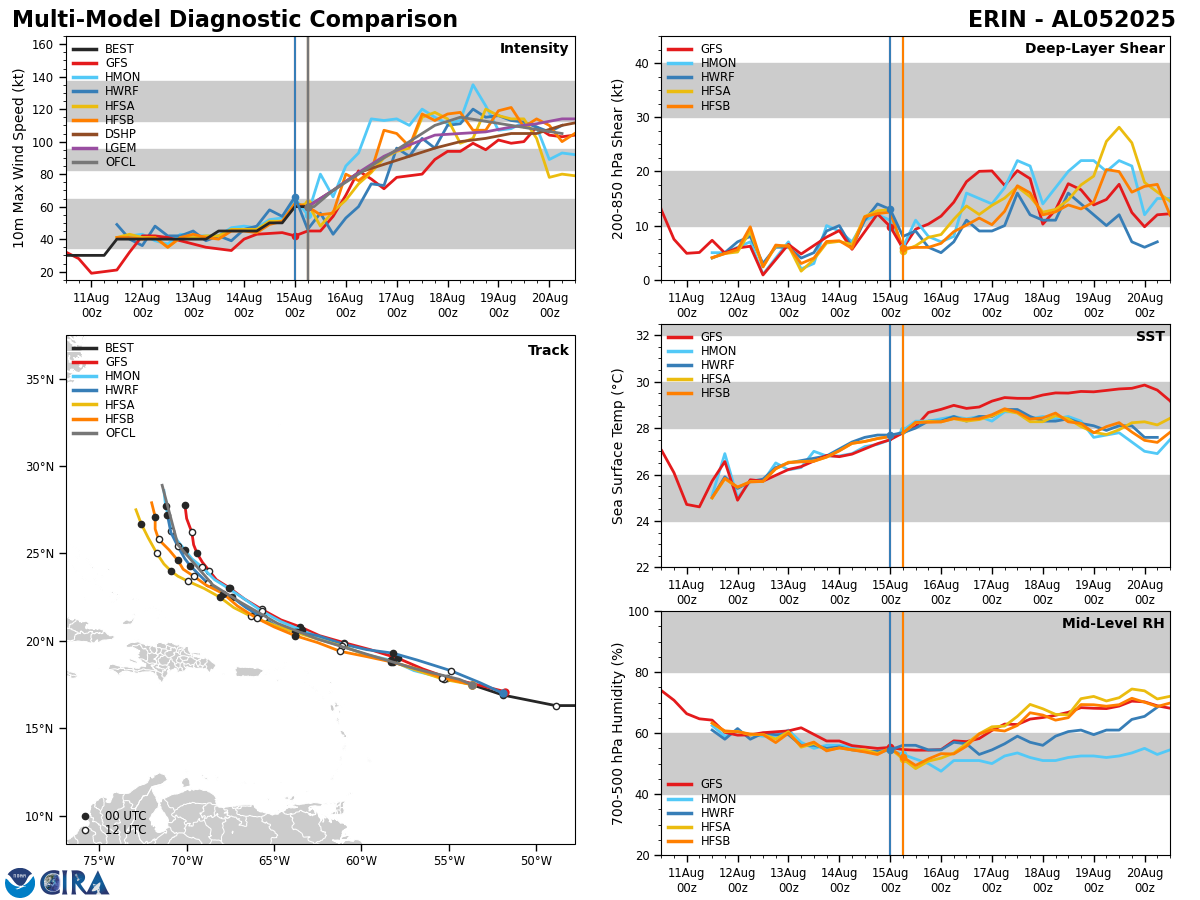Tropical Storm Erin: After becoming quite disorganized with the convection around Erin collapsing last night, it seems as if Erin is organizing today with a small core of deep convection found near the center of the storm. All indications seem to be pointing that Erin is very near hurricane strength right now.
I do think that it is very likely that Erin will become a hurricane as this afternoon or tonight and then strengthen into a major hurricane around Sunday or Monday.
Erin is moving in a west-northwest direction today as it’s being steered by a high pressure ridge that’s found to the north of the storm. This west-northwestward track is likely to continue through this weekend leading to Erin passing north of the Leeward Islands, the Virgin Islands and Puerto Rico.
As we get into the early part of next week, a weakness in the high pressure ridge is expected to cause Erin to turn to a northwesterly direction. How quick and sharp this turn will be is still up for debate & I will discuss this extensively later on in this discussion.
Model Guidance: After trending westward in their forecast tracks of Erin, it seems that any additional westward shifts in the guidance have stopped. It also seems that the track guidance are in pretty decent agreement in forecasting that Erin will probably curve northward and then northeastward about halfway between Bermuda and the East Coast of the United States around the middle and later parts of next week.
This agreement in the guidance that are showing the safe curve to the north and northeast include the track model guidance as well as the higher resolution hurricane models & the Google DeepMind AI models.
There are still questions, however, as to how far west Erin will track before it turns due north. The answer to this question is going to be very important as it’ll determine how close Erin might get to the Bahamas and the outer banks of North Carolina. How quick of a turn to the north occurs will also be important in figuring out how close Erin might get to the island of Bermuda.
Looking at the ensemble model guidance reveals that while a majority of the members turn the storm safely to the north missing both Bermuda and the East Coast of the United States, there are a few members that do show a very close brush with the eastern Bahamas and then a very close brush with the outer banks of North Carolina.
Bottom line is that while the model guidance seems pretty set on showing a fairly safe path in-between Bermuda and the US East Coast, I do still want to watch the model trends very closely, in case they start shifting to the west again.
Here Are My Thoughts: As I already mentioned, I do think that Erin will become a hurricane as soon as this afternoon and I also think that Erin will become a powerful major hurricane by later this weekend and next week.
Based on the data that I’ve looked at today, I do think that the center of Erin will pass about 100 miles or so to the north of the northern Leeward Islands, the Virgin Islands and Puerto Rico during Saturday and Saturday night.
Even though Erin will stay north of the northeastern Caribbean, the outer bands of the storm will affect the northern Leeward Islands, the Virgin Islands, Puerto Rico and Hispaniola throughout this weekend. This means that you should expect locally heavy rainfall bringing localized flooding, some gusty winds and high surf.
Looking towards next week, I agree with the model guidance in their assertion that there will be a weakness in the high pressure ridge & this should cause Erin to turn to the northwest and then to the north. When and how quickly this turn will be remains somewhat uncertain. This is very important as the evolution and position of the weakness in the high pressure ridge will determine how close Erin gets to the Bahamas, Bermuda and the North Carolina Outer Banks.
At this point, I don’t think that we’re going to see a sharp turn to the northwest and north, but instead, a more gradual turn to the northwest and then to the north seems more plausible. This means that Erin should stay just east of the Bahamas by about 100 miles or so. It also means that Erin could get close enough to the eastern and northern Bahamas to bring them tropical storm conditions during Monday into Tuesday and this is something to watch closely.
I also think that Erin will pass offshore of the East Coast of the United States during the middle and later parts of next week, but it’s possible that the storm could track as close as 150 miles or so offshore of the outer banks of North Carolina around Wednesday into Thursday of next week. While this should keep any tropical storm force winds offshore of the Carolina coastline, any sort of a closer approach could introduce tropical storm conditions to the outer banks and far eastern North Carolina around the middle part of next week.
Even though in all likelihood Erin will not directly impact the Bahamas and the East Coast of the United States, it will definitely produce very high surf, dangerous waves and rip currents up and down the US East Coast throughout next week.
Also, it seems most likely that Erin should pass far enough west of Bermuda to not directly impact the island. That said, those of you on the island of Bermuda need to closely monitor the progress of Erin in case it makes a much closer approach around the middle part of next week.
Finally, I want to emphasize that I am going to be watching the steering currents around and to the west and north of Erin extremely closely. It is going to be extremely important for that weakness in the high pressure ridge to develop. In all likelihood, we will see that weakness develop, but if it doesn’t and we see a blocking high pressure ridge remain in place over the northeastern United States, it would block Erin from escaping and instead guide it towards the Bahamas and the US East Coast.
Until we actually see the turn to the northwest and north occur, all interests up and down the East Coast of the United States need to monitor Erin extremely closely. The areas that really need to watch Erin are the Bahamas and areas from eastern North Carolina into coastal Virginia, coastal Maryland and Delaware. Again though, the threat for a direct impact from Erin looks very low, as of right now.



Model Track Forecast:





Satellite Imagery:

Invest 98-L Located Just Offshore Of Northeast Mexico & South Texas: An area of disturbed weather, designated Invest 98-L, is curently located just offshore of coastal northeast Mexico and the lower Texas coast.
Invest 98-L is producing some deep convection today, however, reconnaissance aircraft did not find this system organized enough yesterday to consider it a depression.
There is only a few hours left until Invest 98-L moves inland into the area along the Texas-Mexico border and because of this any development into a depression or a low-end tropical storm will be extremely short-lived.
This system will spread locally heavy rain into parts of northeastern Mexico and South Texas during this afternoon with this locally heavy rain continuing through Saturday.
Additional Tropical Development Possible Over The Eastern Atlantic As We Get Into Next Week: A new tropical wave now located over western Africa is expected to push off of the coast of Africa into the eastern Atlantic during this weekend.
The model guidance such as the GFS model and the European model do show some development from this wave as it heads westward across the Atlantic. That said, the GFS model is much more aggressive with the forecast development of this wave as it approaches the Lesser Antilles and the eastern Caribbean by late next week. In fact, the GFS model forecasts the development of two tropical waves (this one and another right behind it) as they move westward next week.
Analysis of the conditions across the eastern and central Atlantic reveals that the conditions look favorable for development of any waves pushing westward. That said, we don’t know yet what the structure of the wave will be like & whether Erin’s outflow might impart any wind shear over the central and eastern Atlantic as it lifts northward.
This wave and all other tropical waves will be watched closely once it pushes into the eastern Atlantic this weekend, however, I wouldn’t overly stress or worry about it, for now.
The next tropical weather discussion will be issued on Saturday.

